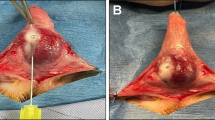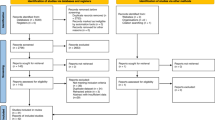Abstract
While the exact mechanism of Peyronie's disease (PD) remains an enigma, the pathophysiology of PD is considered to be multifactorial, with interactions of genetic predisposition, trauma, tissue inflammation and aberrant wound healing. A non-systematic review of the existing English language literature pertaining to the use of rodent models in the evaluation of PD was performed using the Medline database. Multiple free-text searches were performed on key words: animal models of PD, transforming growth factor β1 (TGF β1), tunical and/or corporal fibrosis, subtunical injection and penile myofibroblasts. The most frequently reported models of PD can be classified as TGF β1, fibrin and surgical trauma-induced models. In vitro studies using Peyronie's fibroblast culture media have also provided further insights into cellular mechanism of PD. At the present time, the research in PD is hampered by the lack of universally accepted animal model and this is likely attributed to the limited insight into PD mechanisms and the difficulties faced by current animal models to truly represent the complexity and complete spectrum of human disease.
This is a preview of subscription content, access via your institution
Access options
Subscribe to this journal
Receive 8 print issues and online access
$259.00 per year
only $32.38 per issue
Buy this article
- Purchase on Springer Link
- Instant access to full article PDF
Prices may be subject to local taxes which are calculated during checkout
Similar content being viewed by others
References
Taylor FL, Levine LA . Peyronie's disease. Urol Clin North Am 2007; 34: 517–534.
Mulhall JP, Creech SD, Boorjian SA, Ghaly S, Kim ED, Moty A et al. Subjective and objective analysis of the prevalence of Peyronie's disease in a population of men presenting for prostate cancer screening. J Urol 2004; 171: 2350–2353.
Nelson CJ, Diblasio C, Kendirci M, hellstrom W, Guhring P, Mulhall JP . The chronology of depression and distress in men with Peyronie's disease. J Sex Med 2008; 5: 1985–1990.
Hauck EW, Hauptmann A, Schmelz HU, Bein G, Weidner W, Hackstein H . Prospective analysis of single nucleotide polymorphisms of the transforming growth factor β-1 gene in Peyronie's disease. J Urol 2003; 169: 369–372.
El-Sakka AI, Hassoba HM, Pillarisetty RJ, Dahiya R, Lue TF . Peyronie's disease is associated with an increase in transforming growth factor-beta protein expression. J Urol 1997; 158: 1391–1394.
Gonzalez-Cadavid NF, Rajfer J . Mechanisms of disease: new insights into the cellular and molecular pathology of Peyronie's disease. Nat Clin Pract Urol 2005; 2: 291–297.
Mulhall JP, Anderson MS, Lubrano T, Shankey TV . Peyronie's cell culture model: phenotypic, genotypic and functional analyses. Int J Impot Res 2002; 14: 397–405.
Tomasek JJ, Gabbiani G, Hinz B, Chapponier C, Brown RA . Myofibroblasts and mechano-regulation of connective tissue remodelling. Nat Rev Mol Cell Biol 2002; 3: 349–363.
Vernet D, Nolazco G, Cantini L, Magee TR, Qian A, Rajfer J et al. Evidence that osteogenic progenitor cells in the human tunica albuginea may originate from stem cells: implications for Peyronie's disease. Biol Reprod 2005; 73: 1199–1210.
Vernet D, Ferrini MG, Valente EG, Magee TR, Bou-Gharios G, Rajfer J et al. Effect of nitric oxide on the differentiation of fibroblasts into myofibroblasts in the Peyronie's fibrotic plaque and in its rat model. Nitric Oxide 2002; 7: 262–276.
Mulhall JP, Nicholson B, Pierpaoli S, Lubrano T, Shankey TV . Chromosomal instability is demonstrated by fibroblasts derived from tunica of men with Peyronie's disease. Int J Impot Res 2004; 16: 288–293.
De Young LX, Bella AJ, O’Gorman DB, Gan BS, Lim KB, Brock GB . Protein biomarker analysis of primary Peyronie's disease cells. J Sex Med 2010; 7: 99–106.
Magee TR, Qian A, Rajfer J, Sander FC, Levine LA, Gonzalez-Cadavid NF . Gene expression profiles in the Peyronie's disease plaque. Urology 2002; 59: 451–457.
El-Sakka AI, Hassoba HM, Chui RM, Bhatnagar RS, Dahiya R, Lue TF . An animal model of Peyronie's-like condition associated with an increase of transforming growth factor beta mRNA and protein expression. J Urol 1997; 158: 2284–2290.
Lutz M, Knaus P . Integration of the TGF-beta pathway into the cellular signalling network. Cell Signal 2002; 14: 977–988.
Haag SM, Hauck EW, Szardening-Kirchner C, Diemer T, Cha ES, Weidner W et al. Alterations in the transforming growth factor (TGF)-β pathway as a potential factor in the pathogenesis of Peyronie's disease. Eur Urol 2007; 51: 255–261.
Border WA, Ruoslahti E . Transforming growth factor beta in disease: the dark side of tissue repair. J Clin Invest 1992; 90: 1–7.
Bivalacqua TJ, Diner EK, Novak TE, Vohra Y, Sikka SC, Champion HC et al. A rat model of Peyronie's disease associated with a decrease in erectile activity and an increase in inducible nitric-oxide synthase protein expression. J Urol 2000; 163: 1992–1998.
Ferrini MG, Vernet D, Magee TR, Shahed A, Qian A, Rajfer J et al. Antifibrotic role of inducible nitric oxide synthase. Nitric Oxide 2002; 6: 283–294.
Cantini LP, Ferrini MG, Vernet D, Magee TR, Qian A, Gelfand RA et al. Profibrotic role of myostatin in Peyronie's disease. J Sex Med 2008; 5: 1607–1622.
Artaza J, Singh R, Ferrini MG, Braga M, Tsao J, Gonzalez-Cadavid NF . Myostatin promotes a fibrotic phenotypic switch in multipotent C3H10T1/1 cells without affecting their differentiation into myofibroblasts. J Endocrinol 2008; 196: 235–249.
Ferrini MG, Kovanecz I, Nolazco G, Rajfer J, Gonzalez-Cadavid NF . Effects of long-term treatment with vardenafil on the development of the fibrotic plaque model in rat model of Peyronie's disease. BJU Int 2006; 97: 625–633.
Valente EG, Vernet D, Ferrini MG, Qian A, Rajfer J, Gonzalez-Cadavid NF . L-arginine and PDE inhibitors counteract fibrosis in Peyronie's plaque and related fibroblast cultures. Nitric Oxide 2003; 9: 229–244.
Wen FQ, Liu X, Kobayashi T, Abe S, Fang Q, Kohyama T et al. Interferon-gamma inhibits transforming growth factor-beta production in human epithelial cells by targeting Smads. Am J Respir Cell Mol Biol 2004; 30: 816–822.
Hellstrom WJ, Kendirci M, Matern R, Cockerham Y, Myers L, Sikka SC et al. Single-blind, mulicenter, placebo controlled, parallel study to assess the safety and efficacy of intralesional interferon alpha-2B for minimally invasive treatment for Peyronie's disease. J Urol 2006; 176: 394–398.
Piao S, Ryu JK, Shin HY, Zhang L, Song SU, Han JY et al. Repeated intratunical injection of adenovirus expressing transforming growth factor-beta 1 in rat induces penile curvature with tunical fibrotic plaque: a useful model for the study of Peyronie's disease. Int J Androl 2007; 31: 346–353.
Mosesson MW . Fibrinogen and fibrin structure and functions. J Thromb Haemost 2005; 3: 1894–1904.
Somers KD, Dawson DM, Wright Jr GL, Leffell MS, Rowe MJ, Bluemink GG et al. Cell culture of Peyronie's disease plaque and normal penile tissue. J Urol 1982; 127: 585–588.
Somers KD, Dawson DM . Fibrin deposition in Peyronie's disease plaque. J Urol 1997; 157: 311–315.
Merlo G, Ambroggio GP, Castagna B, Mosca A, Oberto E . Fibrin/fibrinogen and fibronolytic activity of the palmar fascia in Dupuytren's contracture. J Hand Surg 1986; 11: 55–57.
Somers KD, Winters BM, Dawson DM, Leffell MS, Wright Jr GL, Devine Jr CJ et al. Chromosomal abnormalities in Peyronie's disease. J Urol 1987; 137: 672–675.
Davila HH, Ferrini MG, Rajfer J, Gonzalez-Cadavid NF . Fibrin as an inducer of fibrosis in the tunica albuginea of rat: a new animal model of Peyronie's disease. BJU Int 2003; 91: 830–838.
Davila HH, Magee TR, Zuniga FI, Rajfer J, Gonzalez-Cadavid NF . Peyronie's disease associated with increase in plasminogen activator inhibitor in fibrotic plaque. Urology 2005; 65: 645–648.
El-Sakka AI, Selph CA, Yen TS, Dahiya R, Lue TF . The effect of surgical trauma on rat tunica albuginea. J Urol 1998; 159: 1700–1707.
Lucattelli M, Lunghi B, Fineshi S, Mirone V, d’Emmanuele di Villa Bianca R, Longo N et al. A new mouse model of Peyronie's disease: an increased expression of hypoxia-inducible factor-1 target genes during the development of penile changes. Int J Biochem Cell Biol 2008; 40: 2638–2648.
Lemaire R, Bayle J, Lafyatis R . Fibrillin in Marfan syndrome and tight skin mice provides new insights into transforming growth factor beta regulation and systemic sclerosis. Curr Opin Rheumatol 2006; 18: 582–587.
Del Carlo M, Cole AA, Levine LA . Differential calcium independent regulation of matrix metalloproteinases and tissue inhibitors of matrix metalloproteinases by interleukins-1β and transforming growth factor-β in Peyronie's plaque fibroblasts. J Urol 2008; 179: 2447–2455.
Author information
Authors and Affiliations
Corresponding author
Ethics declarations
Competing interests
The authors declare no conflict of interest.
Rights and permissions
About this article
Cite this article
Chung, E., De Young, L. & Brock, G. Rat as an animal model for Peyronie's disease research: a review of current methods and the peer-reviewed literature. Int J Impot Res 23, 235–241 (2011). https://doi.org/10.1038/ijir.2011.36
Received:
Revised:
Accepted:
Published:
Issue Date:
DOI: https://doi.org/10.1038/ijir.2011.36
Keywords
This article is cited by
-
Unveiling the molecular Hallmarks of Peyronie’s disease: a comprehensive narrative review
International Journal of Impotence Research (2024)
-
Characterization of a novel rabbit model of Peyronie’s disease
International Journal of Impotence Research (2023)
-
Nonsurgical management of Peyronie’s disease
Nature Reviews Urology (2019)
-
The mechanisms and potential of stem cell therapy for penile fibrosis
Nature Reviews Urology (2019)
-
Extracellular matrix alterations after blood instillation in tunica albuginea of rats
International Journal of Impotence Research (2018)



